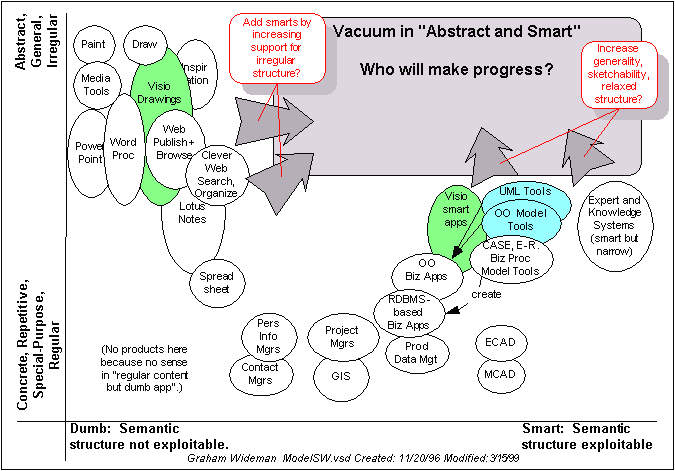Last edit: 05-03-17 Graham Wideman
| Last edit: 05-03-17 Graham Wideman |
Intelligence and Change in Enterprises |
| Concept Modeling: What It Is, and Where's The
Software? Article created: 99-03-01 |
Concept Modeling can refer to a number of formal or informal techniques for capturing and manipulating concepts, using a vocabulary that provides more structure than simple narrative text. These days that invariably calls on the support of a software environment of some type. Such an environment often (usually?) provides a graphical view, and the structuring aspect of the environment is often leveraged by automated processes to produce some useful downstream deliverables.
Implementation of tools with significant semantic depth has been most feasible where funded by commercial viability. Examples include:
Of these, the developing UML initiative is particularly interesting, as its real-world-modeling capability expands in an attempt to model everything of interest to business and systems developers -- which is an ever increasing portion of the known universe. Although UML will by no means subsume all other modeling endeavors any time soon, the UML effort is very instructive regarding the kinds of modeling concepts that might be usefully applied in other domains.
Concept modeling makes concepts explicit (notably including relationships), enabling individuals to comprehend and think about a topic far more powerfully and quickly. Equally significantly, it enables groups of participants to build and communicate a shared understanding of a domain, and to efficiently collaborate on developing it further. This theme is explored further in "Thinking with Diagrams".
Therefore, of significant interest is the status of the forefront of the concept modeling area, as this is the area where domains of human endeavor are transitioning from "wallowing in narrative" to "surfing on a wave of understanding". (Some calibration on human progress is explored in "Evolution of the Human Relationship to Knowledge"). For example, the ability to model business features and phenomena (beyond existing relatively rigid systems tools) would be a powerful management tool. (The "Fifth Discipline" and "Organizational Learning" threads take up this issue.)
At the forefront of model use, there is something of a Catch-22. Participants struggle to capture and express concepts with tools that don't fit properly. At the same time tools that do fit are slow to appear since, without a widely adopted technique, it's not clear what specific tool to build. This situation would be relieved by tools which support easy ad hoc construction of the symbols and semantics that participants need for a particular area. This is a tall order, but some tools are poised near this goal.
The following diagram summarizes the state of affairs.

The programmable drawing environment Visio is one of the tools that has some promise of facilitating progress. My collection of Visio notes and observations is here.